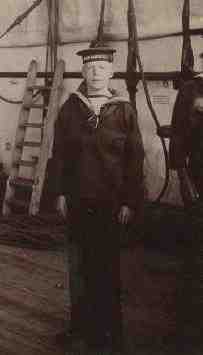military uniform background: influence on boys' clothing

Military Uniform Background: Influence on Boys Clothes

Figure 1.--No miliary uniform has had more impact on children's clothes than sailor suits. The suits commonly worn in each country were based on the contemporary style of the national navies. This tennage boy has just entered the English Navy at about the turn of the century.
|
HBC thought that some basic information about military uniform trends might help to put some of the changes in boys' uniforms and eventually non-uniform fashions in perspective. There appear to have been inluences back and forth between military and civilian dress.
HBC has noted major fashion changes have followed important conflicts. Some of the most important shifts boy's fashions have indded follow or occured during major wars or upheavals.
Influences
Military styles haveen highly influential in men and boys' clothing. Military uniform details also show up in civilian clothes. One military uniform specialist not familiar with with fashion history in the civilian population, notes that military fashion, has followed civilian fashion for the most part.
Military Uniform Background
Early uniforms
The first military uniforms took ideas from the fashions of the day and incorporated the same ones for everyone to wear, hence he name, "uniform". Uniforms originally being a way to clearly delineate which soldiers were on which side.
Civil War (1861-65)
In the Civil War, items such as hats, coats, shirts, ties and footwear were all styled on civilian fashion and often changed with civilian fashion during the war, at least on the Union side. The one exception may have been the Zouave uniforms with a French North african influence. For the Confederates, much the same applies, except that uniform items were less common. And also, the Confederates were much more likely to wear their civilian clothes to the battlefield, as the Confederacy could often not afford to uniform their soldiers.
World War I
In World War I, it is possible to see a definite civilian influence on the way that soldiers dressed. For the first time, soldiers have both utility and dress uniforms, though even their utility uniforms included such things as spats, which are a direct import from the civilian world of the time. High, stiff collars, tight-fitting jackets and the dearth of boots though they were available also indicate a high reliance on civilian fashion.
World War II
In WWII we start to see real utility uniforms that are designed without fashion in mind so much as function. They are drab green and feature lots of pockets and other things to make them more useful in combat. However, dress uniforms continue to imitate civilian styles. The high collar on the jackets begins to drop, the belt worn outside the jacket is removed, and the collar modifies to be identical with that which is popular in civilian life.
After World War II
After World War II and Korea and especially after
Vietnam, untility uniforms begin to influence civilian style, first by being worn simply as they are, and then with the emergence of "cargo pants" and the like. But military dress uniforms have continued their move to be like civilian clothes. Just in the last 5 years or so, there was an enormous debate in the Air Force over whether or not to alter their dress uniform. They eventually did, changing from 4 buttons to two on their jacket, removing the patches from the sleeves, removing
the buttons from the two lower jacket pockets, disposing of the right hand breast pocket and removing the button from the left hand breast pocket. In other words, it now looks like a blue sportcoat.
Relative Influences
One expert in military uniforms speculates that uniform styles have come basically from civilian styles. HBC is less sure about his and asks, just thinking about caps, I don't seem to recall civilian versions of Civil War caps (the type with the front peak and slanted top) or the World War I campaign caps. Or caps an exception to the military drawing styles from civilian life? Also what about all those buttons that Hussars wore, didn't that lead to civilian fashiions like heavily buttoned skeleton suits and mens's double breasted suits?
The uniform expert replies, I must confess ignorance as to the fashions surrounding the Hussars. I would speculate that this was possibly the time when military and civilian dress fashions began to diverge significantly. I don't know. As to Civil War caps, I also do not know of a civilian equivilent to kind you mention. I was thinking of officers hats, especially those worn by cavalry. Many of these look like rather dandified cowboy hats or various other wide-brimmed hats worn by agricultural people. Note the similarities in modern DI hats, state trooper hats, forest ranger hats,
and... the Amish of all people. All wide brimmed, fairly stiff with a somewhat circular domed center. Direct lineage of modern hats like the "frisbee" officer hat, I don't know for certain however. I also think I may have left an unintended perception with my last answer. I did not mean to say that I think military styles derived exclusively from civilian life and that influence has never been reciprocal. There is no doubt in my mind that military styles did affect civilian styles, but if I had to pick an one direction in which most of the influence flowed, I would say civilian to military.
Christopher Wagner
histclo@lycosmail.com
Navigate the Historic Boys' Clothing Web Site:
[Return to the Main military style page]
[Introduction]
[Chronologies]
[Style Index]
[Biographies]
[Bibliographies]
[Contributions]
[Frequently Asked Questions]
[Links]
[Boys' Clothing Home]
Created: September 4, 1998
Last updated: April 7, 2000


